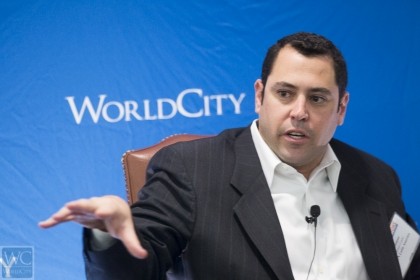Media in the Americas: What’s now, what’s next

Years ago, a movie that debuted in the United States could take six months to a year to reach Latin American theaters.
Today, films often premiere in key U.S. and Latin American cities the same week.
That’s just one example of the quickening pace of change in the media landscape in Latin America, panelists said at WorldCity’s Global Connections held April 25 and attended by more than 75 people.
Pay TV shows the shifts, opportunities and challenges.
Today, the cable and satellite TV business is booming across Latin America, as millions more people have joined the middle class and can afford the service. A+E Networks has boosted its staff beyond 300 people in offices across the region, said Eddy Ruiz, president and general manager for A+E Latin America, pictured above.
Yet headaches abound for the flourishing industry.
Argentina’s government wants to limit pay TV advertising time and mandate some ads be made locally. Brazil’s fund to help finance required local TV productions can be tough to access. And many Latin Americans still steal signals without paying cable or satellite companies, he said.
Competition for pay TV from the Internet
New technologies and platforms also pose growing competition, including videos available on the Internet and downloaded on smartphones, tablets and personal computers.
“The next five years in technology,” Ruiz said, “who knows what vehicles will be available?”

Alfonso Cueto, senior director of multimedia sales for ESPN Latin America
Sports group ESPN has an edge to compete, because the live sports events it broadcasts on pay TV command huge audiences, said Alfonso Cueto, senior director of multimedia sales for ESPN Latin America. Viewers don’t want to wait until big events end to watch them on less costly platforms.
Indeed, ESPN is the most profitable unit within The Walt Disney Co. empire, said Cueto.
Yet even ESPN is seeking ad revenues beyond TV on digital platforms these days.
Creating original content: How to appeal globally
Another option to build future revenues is creating more original content that can be sold on different platforms, from video-on-demand to websites. A +E increasingly is making its own programs, with recent successes including the Storage Wars and Pawn Stars series that are “character driven,” said Ruiz.
But developing content that can appeal across borders is not easy, ESPN has found.
When it comes to sports talk shows, Colombians want to learn about their favorite teams from commentators that speak Spanish with their accent. Brazilians instead want to in hear about their own teams in Portuguese, said Cueto.
“Latin America is not one market,” but rather dozens marked by different cultures and idioms, said Ruiz. “One word means something in Mexico and something else – bad – in Argentina. “
What tends to work best across Latin America for A+E viewers are shows about UFOs and “anything that has to do with miracles,” quipped Ruiz.
Finding and keeping talent
Global Connections participants had plenty of questions.

Fernando Figueredo, director of career services at Florida International University.
What are companies doing to recruit and retain talent for the growing pay-TV business in Latin America?, asked Fernando Figueredo, director of career services at Florida International University.
“We steal from each other all the time,” said Ruiz, only partly joking. He said the Miami area presents serious challenges, because many U.S. Hispanics do not write well in Spanish. Plus, many Brazilians living in Florida for years sometimes lose their connectedness to Brazil’s business culture, said Ruiz.
Where do companies seek talent to try to figure out the tech future?, asked Tom Shea, president of Right Management Florida/Caribbean.
ESPN depends mainly on personnel in the United States. “The US is a like a crystal ball for Latin America,” although the time lag for tech adoption keeps shortening, said Cueto.
What’s different in Latin American media compared to the US or other markets?, asked Tak Takasu, a management consultant specialized in competitive intelligence and strategic analysis.
Latin America dominates the world in “novelas,” especially series from Brazil, Mexico and Colombia. Brazilian series can run 300 chapters, complete with period costumes in multimillion-dollar productions.
“Many countries have tried to do similar productions and can’t,” said Ruiz.
From the Web to TV?
Also gaining ground across Latin America now are locally-made video series available on YouTube and other sites in episodes of three or four minutes each, said Diana Figueroa, chief executive of content development company Visionnaire Business, which has offices in Colombia and Miami.
A+E is tapping that model too, developing “web-isodes,” said Ruiz. “If they work, we’ll take it to TV.”
Global Connections is one of six event series organized by media company WorldCity to bring together executives in greater Miami on international business topics. The Global series is sponsored by real estate company Waterford at Blue Lagoon, public relations giant Edelman, heating and air-conditioning equipment maker Daikin and FIU School of Business.
The next Global Connections event is set for May 30 on the topic, “Billion-Dollar Bosses: Secrets from some sophisticated managers.”